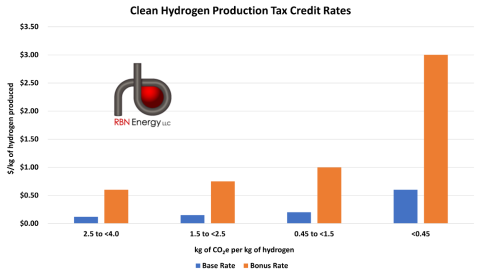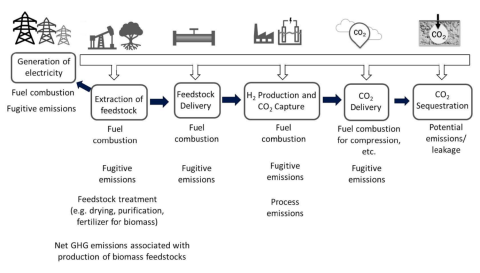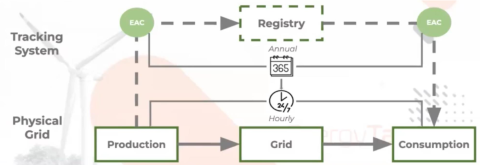Clean Hydrogen Rules Focus On 'Three Pillars,' Strict Approach To Hourly Matching
The long-delayed rules around the federal government’s Hydrogen Production Tax Credit (PTC), also known as 45V, have been the subject of heated debate (and lobbying) since the passage of the Inflation Reduction Act (IRA) in August 2022. While some industry groups argued for looser guidelines around the PTC that would allow the low-carbon hydrogen industry to grow quickly, others called for a stricter set of rules from the start, arguing that an approach that was too lax would lead to an increase in greenhouse gas (GHG) emissions. In today’s RBN blog, we’ll look at how those newly published rules rely on the so-called “three pillars” of clean hydrogen, how they prioritize the production of green hydrogen at the expense of its blue and pink varieties, and explain the rules around temporal matching and why it might be hard to hit the administration’s 2028 target date for implementation.
The guidelines around the PTC were widely expected to be announced by August 2023, but as summer turned into fall, and fall into winter, it was clear that the debates over 45V were continuing inside the Biden administration. The rules were finally rolled out on December 22. (They closely followed a leaked draft of the guidelines, which we discussed in the December 6 edition of our Hydrogen Billboard report.) Publication of the proposed rulemaking began a 60-day comment period. The industry now has until February 26 to comment on this set of proposed rules before the issuance of a “final” rule which may not come out until several weeks later.
The implementation of those rules is important, as the Biden administration has made clean hydrogen a major element in its decarbonization plans, with the federal government’s Regional Clean Hydrogen Hubs (H2Hubs) initiative intended to accelerate the process. As we noted in The Contenders, the Department of Energy (DOE) opened up $7 billion in funding in September 2022 for the development of several regional hubs. After sifting through dozens of concept papers and months of deliberation, the DOE in October 2023 picked seven hub projects intended to help meet the Biden administration’s targets of producing 10 million metric tons per annum (MMtpa) of clean hydrogen by 2030, 20 MMtpa by 2040, and 50 MMtpa by 2050.
Figure 1. Breakdown of 45 V Tax Credit. Source: Treasury Department
As defined by the IRA, clean hydrogen is produced in a way that results in a lifecycle GHG emissions rate of not more than 4 kg of carbon dioxide (CO2) equivalent per kilogram of hydrogen (CO2e/kg). Under 45V, credits with up to $3/kilogram (kg) are available based on the rate of lifecycle GHG emissions (X axis is Figure 1 above) during a clean hydrogen facility’s first 10 years of operation. The PTC includes a base rate (blue bars) and a bonus rate (orange bars), which is 5X the base rate and is for producers that meet prevailing wage and apprenticeship requirements. Clean hydrogen’s lifecycle GHG emissions are calculated by examining every step in the production process, starting with the generation of electricity, as shown in Figure 2 below.
Figure 2. Lifecycle Greenhouse Gas Emissions for Hydrogen Production. Source: hydrogen-central.com
Although the credit is intended to be process-neutral, the proposed rules are set up in such a way that the tax credit is primarily directed at green hydrogen, which is produced through electrolysis using renewable energy. Under the proposed rules, PTC eligibility for producers of blue hydrogen (produced through the auto thermal reforming or steam methane reforming of natural gas, with the resulting emissions mitigated by carbon capture) and pink hydrogen (where the electricity used for electrolyzers is supplied by a nuclear power plant) is less certain and includes additional challenges that affect their ability to qualify for the tax credit. Those distinctions are important because the proposed rules have the potential to significantly impact the goal of boosting clean hydrogen production. RBN’s weekly Hydrogen Billboard report shows that blue hydrogen projects account for roughly two-thirds of the capacity expected to come online in the next few years, so reduced PTC eligibility is likely to be a major consideration in determining the fate of those projects. Pink hydrogen is very limited at the moment, but it’s thought to have considerable long-term potential. (We should note that green hydrogen producers are also challenged by the new rules, especially the need for new sources of power generation. We’ll touch on that in a future blog.)
A blue hydrogen project can qualify for credit under 45V if it has sufficiently high carbon-capture rates, but the proposed regulations likely limit it to the bottom two tiers of the credit (left-hand columns in Figure 1) due to a “locked” upstream natural gas feedstock emissions factor. Pink hydrogen projects would qualify based on carbon intensity but will face significant challenges complying with the currently proposed additionality requirements in sourcing nuclear energy, although the Treasury and Internal Revenue Service (IRS) are requesting comment on nuclear retirement and considerations for avoided retirement as a form of incrementality. Neither pink hydrogen nor hydrogen from renewable natural gas (RNG) is fully addressed in the proposed rules, and several questions are listed in the proposed rules for the industry to address on these topics. Presumably, either a subsequent revision to the proposed rules or the final rule will address those methods.
Figure 3. Schematic for Energy Attribute Certificate Generation. Source: Greenfact
The proposed guidance relies on the use of energy attribute certificates (EACs) to demonstrate a hydrogen producer’s purchase of clean power. As shown in Figure 3, EACs are issued as proof of electricity produced by renewable sources. Each EAC verifies that 1 megawatt-hour (MWh) of electricity used by an electrolyzer was generated by 1 MWh generated from a renewable source, typically wind or solar. (We should note that the DOE’s GREET model used to determine lifecycle GHG emissions in hydrogen production includes a 5% loss assumption from electricity transmission and distribution, which would have to be factored into any emissions analysis.) The guidelines establish the critical criteria — as we said, these are often referred to as the “three pillars” of clean hydrogen — that must be reflected in the EACs needed to claim the tax credit:
- Additionality requires the electricity for hydrogen production to come from new clean generation sources or an increase in the rate of electricity production from existing clean generation (known as uprating).
- Deliverability requires electrolyzers to source clean electricity from within their same operating region.
- Temporal matching — the focus of today’s blog — requires electrolyzers’ electric consumption to match clean energy production over a set time frame (i.e., annual, monthly, or hourly).
Under the proposed rules, EACs will generally need to be matched to production on an hourly basis starting in 2028 — meaning that the claimed power generation for hydrogen production must occur within the same hour that the electrolyzer claiming the credit is operating. In that example, an electrolyzer running on renewable sources of generation would have to reduce output or shut down when those power sources are generating at lower levels or offline. The proposed rules include a transition to allow annual matching through 2027, by which time hourly tracking systems are expected to be more widely available. Annual matching allows producers to keep their electrolyzers running at all hours and in all conditions as long as the amount of renewable energy produced matches the amount of power consumed by the electrolyzers over the course of the year, a much easier threshold to meet. Annual matching is generally assumed to lower costs and boost production but comes with the potential to increase GHG emissions when electrolyzers pull energy from the power grid if/when their sources of renewable power are unavailable or underperforming, leading to an increased reliance on gas- and coal-fired power to meet overall demand, or pulling renewable energy from the grid that must be made up for elsewhere by dispatchable sources.
The U.S. approach to temporal matching differs from the European Union (EU) rules in two important ways:
- Speed of transition: The proposed rules require U.S. producers to meet hourly matching requirements in 2028. In the EU, producers don’t need to meet hourly requirements until 2030.
- Transition period: U.S. producers might have to move faster than those in Europe, but they do have an easier standard to meet in the meantime. U.S. producers only need to meet annual matching before 2028. (According to the Notice of Proposed Rulemaking published December 26 in the Federal Register, the transition period is intended to provide time for the EAC market to develop the hourly tracking capability necessary to verify compliance. More on that in a bit.) Europe’s mandate for monthly matching until 2030 is a little stricter by comparison, with the eventual move to hourly matching the most challenging for producers in both areas.
To implement hourly matching, EACs would need to be tagged with the time they were generated and issued, but it’s important to note that EAC used to date — such as for compliance with a state’s renewable portfolio standard — have mostly required only annual matching. Hourly tracking for EACs is not widely available, and even though they are in effect or under development in some regions, widespread availability and functionality will take some time, according to a DOE report on 45V implementation. Power grid operators already track the real-time production of electric generators connected to the transmission system, but data, software, regulatory structures, and market practices will need to improve and evolve to allow for hourly matching to be done at the necessary scale.
It’s by no means a sure thing that hourly matching will be functional and widely available by 2028. Two tracking systems recently began offering EACs with hourly data — the Midwest Renewable Energy Tracking System (M-RETS) and the PJM Generation Attribute Tracking System (PJM-GATS) — but limitations remain for both. (We should also note that M-RETS has said it can register projects across North America and will support imports and exports with any registry in North America.) For the other seven EAC tracking systems in place nationwide, one said in a DOE survey it would take three to five years to develop hourly tracking, four said it would take two years or less, and two declined to give an estimate. They identified many challenges to faster implementation, including costs, regulatory approval, interactions with state policy, stakeholder engagement, data availability and management, and user confusion. Once the tracking software is in place nationwide, it may take additional time for transaction structures and efficient hourly markets for EACs to develop.
The DOE also notes that in addition to the challenge around hourly tracking, the treatment of electricity storage will also require a resolution. Going back to the scenario noted above, where electrolyzers would have to reduce output or shut down when intermittent power sources are reduced or offline, it’s possible the final rule will allow for those electrolyzers to remain online if they are powered by batteries that were charged by renewable generation.
The guidance published on December 22 was based in part on submissions to the Treasury Department and the IRS after they requested public comment on several issues in November 2022. The newly proposed rulemaking seeks additional comment (due February 26) in several areas, including two areas specific to temporal matching, which hint at the potential for additional revisions in the final rulemaking:
- The appropriate duration of this transition rule to hourly matching, including specific data regarding current industry practices, the predicted timelines for the development of hourly tracking mechanisms, and the predicted timeline for market development for hourly EACs.
- The extent and manner in which temporal matching, incrementality, and deliverability should be applied in accounting for existing or new electricity generation from biomass or fossil (natural gas and coal) feedstock.
We’ll be watching to see if the publication of the proposed rules leads to a surge in announced projects, much like what happened with U.S. battery manufacturing in the months after the IRA was passed. In our next blog, we’ll look at another of the “three pillars” of clean hydrogen — deliverability — and how the proposed rules are designed to link clean hydrogen production with regional power supplies.
“Gimme Three Steps” was written by Ronnie Van Zant and Allen Collins and appears as the third cut on side one of Lynyrd Skynyrd’s debut album, Pronounced Leh-nerd Skin-nerd. The song was written about an incident that happened to singer Ronnie Van Zant at a bar in Jacksonville, FL, called The Pastime. Ironically, “Gimme Three Steps” failed to chart when it was released as a single in November 1973; it has since become one of the band’s most popular songs. On a side note, mega-selling Los Angeles band Poison played this song regularly as a part of their set in LA clubs before being signed to their first record deal. Personnel on the record were: Ronnie Van Zant (vocals), Gary Rossington (lead guitar), Allen Collins (guitar), Ed King (bass), Billy Powell (keyboards), and Bob Burns (drums).
Pronounced Leh-nerd Skin-nerd was recorded between March and May of 12973 at Studio One in Doraville, GA, with Al Kooper producing. Most of the songs on the album had been played and tested live for some time and were rehearsed to perfection at the band’s rehearsal space: Hell House, a non-air-conditioned cabin with a tin roof outside of Jacksonville, FL. They liked the spot because they could play loudly at all hours with no neighbors or police within earshot. Hell House has since burned to the ground and the land on which it sat is now a gated residential subdivision with street names that pay homage to Lynyrd Skynyrd song titles. The album was released in August 1973 and went to #27 on the Billboard 200 Albums chart. It has been certified 2x platinum by the Recording Industry Association of America. Two singles were released from the LP.
Lynyrd Skynyrd is an American rock band formed in Jacksonville. FL. The band’s roots go back to 1964, performing under a variety of names, with different personnel, before deciding on the moniker Lynyrd Skynyrd in 1969. The name came from Leonard Skinner, a high school gym coach in Jacksonville who hated rock and roll and long-haired guys who played it. They have released 14 studio albums, 14 live albums, 23 compilation albums, and 30 singles. The band was inducted into the Rock and Roll Hall of Fame in 2005. More than two dozen band members have passed through their ranks since their formation. The last original member, Gary Rossington, passed away in March 2023 at the age of 71. Rossington hand-picked Damon Johnson (Brother Cane, Black Star Riders) to be his replacement. Cane, along with Johnny Van Zant, Rickey Medlocke, Michael Cartellone, Mark Matejka, Peter Keys, and Keith Christopher, continue to record and tour as Lynyrd Skynyrd. After touring the states last year on the mega-successful Sharp Dressed Simple Man Tour with ZZ Top, the band will begin their Celebrating 50 Years of Lynyrd Skynyrd Tour at the end of December 2023.
You can return to the main Market News page, or press the Back button on your browser.




